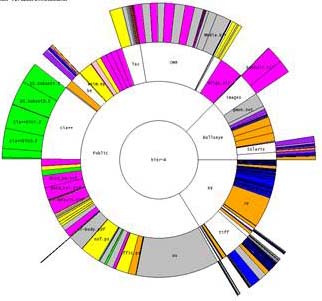Overview
This is the course website for HCDE 511, Information Visualization.
The goal of information visualization is the unveiling of the underlying structure of large or abstract data sets using visual representations that utilize the powerful processing capabilities of the human visual perceptual system.
Instructor
Cecilia Aragon
407A Sieg Hall, 206-221-0323
Office Hours: By appointment
Best way to contact me is via email: aragon (at) uw. edu
Course Objectives
In this course, we will analyze the factors contributing to the creation of successful visualizations. Criteria for success in this analysis are either positive results from usability studies or wide adoption by the target user population. This course will also have a focus on how to present information clearly and effectively.
The following topics will be included: The design and presentation of digital information. Use of graphics, animation, sound, visualization software, and hypermedia in presenting information to the user. Vision and perception. Methods of presenting complex information to enhance comprehension and analysis. Incorporation of visualization techniques into human-computer interfaces.
There are many related topics that this class will not address. These include: scientific visualization, cartography, computer graphics, and visualization as an artistic enterprise.
This class will have a research focus and is intended for PhD students. Students will complete a group research project that will consist either of creating or enhancing a visualization system or technique, or conducting a user study to evaluate a system or technique. Projects will be interdisciplinary in nature and in most cases will involve programming, visualization design, and user interface design. Students will be expected to write up the results of the project in the form of a conference paper submission.
This course is originally based on the class designed by my PhD advisor Marti Hearst, from the UC Berkeley School of Information. I also include material from Maneesh Agrawala's visualization course in EECS at Berkeley. All material is used with permission.
Class Meetings
Class meets on Tuesdays and Thursdays from 11:30am-1:20pm in 228 Sieg Hall. The format of the class will be a mix of lecturing, looking at visualizations, student presentations and in-class design and activities.
Class CommonView Site and Discussion Board
https://catalyst.uw.edu/workspace/aragon/26897https://catalyst.uw.edu/gopost/board/aragon/25969
Grading
Grades will be determined as follows:
- 30% assignments
- 10% in-class work
- 10% readings and class participation
- 50% final project
Late assignments will be accepted for one week past the due date for up to 50% credit. Beyond one week, assignments will not be accepted and you will receive a zero for that assignment. In-class work and class participation cannot be made up. If you miss a class, you will receive a zero for the work done in class that day. Required posts to the class discussion board must be made within one week of the class date or you will receive a zero for that work.
Final projects cannot be turned in late.
Grade Book: https://catalyst.uw.edu/gradebook/aragon/59390
Readings and Books
Readings will consist of one required text: Stephen Few's Now You See It, and a number of papers that will be accessible online or handed out in class.
Highly recommended but not required:
- Edward Tufte's The Visual Display of Quantitative Information.
- Colin Ware's Information Visualization: Perception for Design, 2nd ed., 2004.
Guide to using the Tableau software package:
The Beginner's Guide to Data Visualization.
Software
We'll be using the Tableau software package. You will receive a code for accessing it; do not share this with others. It only works under Windows, so Mac users will have to use a virtual machine (UW has a VMware license) or use a designated lab machine. Tableau's data visualization software is provided through the Tableau for Teaching program.We will also be working with d3, a free JavaScript library for manipulating documents based on data. (From the designers of Protovis.)
